1993 CADILLAC FLEETWOOD load capacity
[x] Cancel search: load capacityPage 150 of 386

Downloaded from www.Manualslib.com manuals search engine i
FUEL GAGE
fI
I
Your fuel gage shows
about how much fuel is
in your tank.
It works only when the ignition is in the “RUN” position. The
17 bar
segments show the fuel remaining in your tank.
When only one bar segment still is lit, the
“LOW FUEC’ light will go on.
If the fuel supply gets critically low, none of the bar segments will be lit
and the
“LOW FUEC’ will flash. You should get fuel immediately.
Here are
a few concerns some owners have had about the fuel gage. All
these situations are normal and indicate nothing wrong with the fuel
gage.
The pump at the gas station shuts off before the fuel gage reads “F”.
I.
3, I
It takes more (or less) gas to fill up than the gage said. For example,
the gage said
“l/Y, but it took more or less than half the tank capacity -
to fill it. I
The gage changes when you turn (or stop,or speed up)
OIL LIFE INDICATOR
Your Cadillac has an Oil Life Indicator feature. This tells you when you
need to change your engine
oil. It’s based upon the engine oil
temperatures and your driving patterns.
-1
-1
The “CHANGE OIE’ light will come on for a few seconds as a bulb check
when
you start your engine. The system probably will say to change the oil
-.
n
- I
136
Page 222 of 386
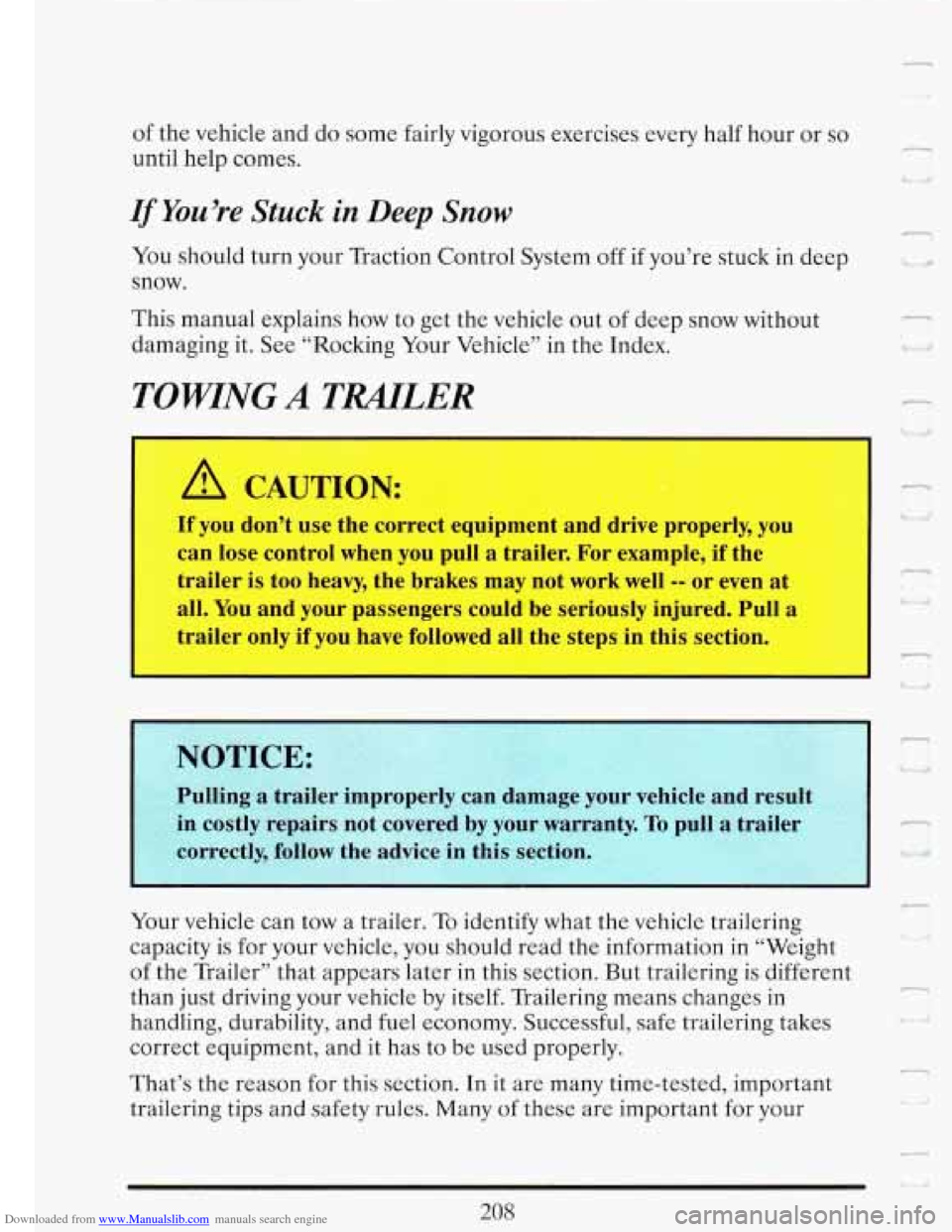
Downloaded from www.Manualslib.com manuals search engine of the vehicle and do some fairly vigorous exercises every half hour or so
until help comes.
If You’re Stuck in Deep Snow
You should turn your Traction Control System off if you’re stuck in deep
snow.
This manual explains how
to get the vehicle out of deep snow without
damaging it. See “Rocking Your Vehicle” in the Index.
TOWING A TMLER
A CAUTION:
If you don’t use the correct equipment and drive properly, you
can lose control when you pull a trailer. For example, if the
trailer is too heavy, the brakes may not work well
-- or even at
all.
You and your passengers could be seriously injured. Pull a
trailer only if you have followed all the steps in this section.
I
~~ ~ ~~ id
7
\. i
Pulling a trailer improperly can damage your vehicle and result
in costly repairs not covered by your warranty.
To pull a trailer -
c*
Your vehicle can tow a trailer. To identify what the vehicle trailering ;
capacity is for your vehicle, you should read the information in “Weight
of the Trailer” that appears later in this section. But trailering is different
than just driving your vehicle by itself. Trailering means changes in
handling, durability, and fuel economy. Successful, safe trailering takes
correct equipment, and it has to be used properly.
-
That’s the reason for this section. In it are many time-tested, important
trailering tips and safety rules. Many of these are important for your m .> d
c-
.J ~
208
Page 224 of 386
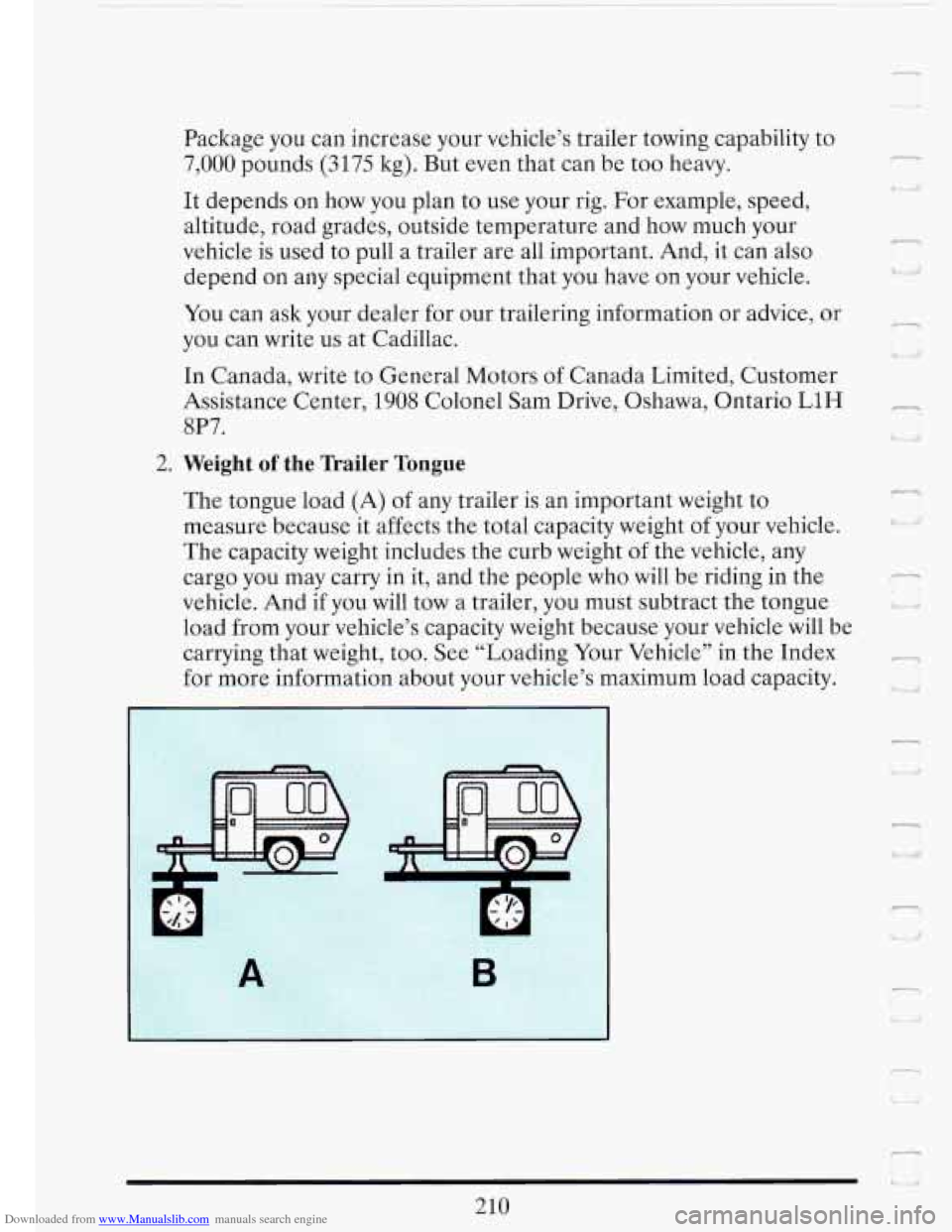
Downloaded from www.Manualslib.com manuals search engine I
Package you can increase your vehicle’s trailer towing capability to
7,000 pounds (3175 kg). But even that can be too heavy.
It depends on how you plan to use your rig. For example, speed,
altitude, road grades, outside temperature and how much your
vehicle is used to pull a trailer are all important. And, it can also
depend
on any special equipment that you have on your vehicle.
You can ask your dealer for our trailering information or advice, or
you can write us at Cadillac.
In Canada, write to General Motors
of Canada Limited, Customer
Assistance Center,
1908 Colonel Sam Drive, Oshawa, Ontario L1H
8P7.
2. Weight of the nailer Tongue
I
-1
P
‘Li I
The tongue load (A) of any trailer is an important weight to
measure because it affects the total capacity weight
of your vehicle.
The capacity weight includes the curb weight
of the vehicle, any
cargo
you may carry in it, and the people who will be riding in the
vehicle. And if you will tow a trailer, you must subtract the tongue
3
load from your vehicle’s capacity weight because your vehicle will be I
carrying that weight, too. See “Loading Your Vehicle’’ in the Index
for more information about your vehicle’s maximum load capacity.
210
T
Page 269 of 386
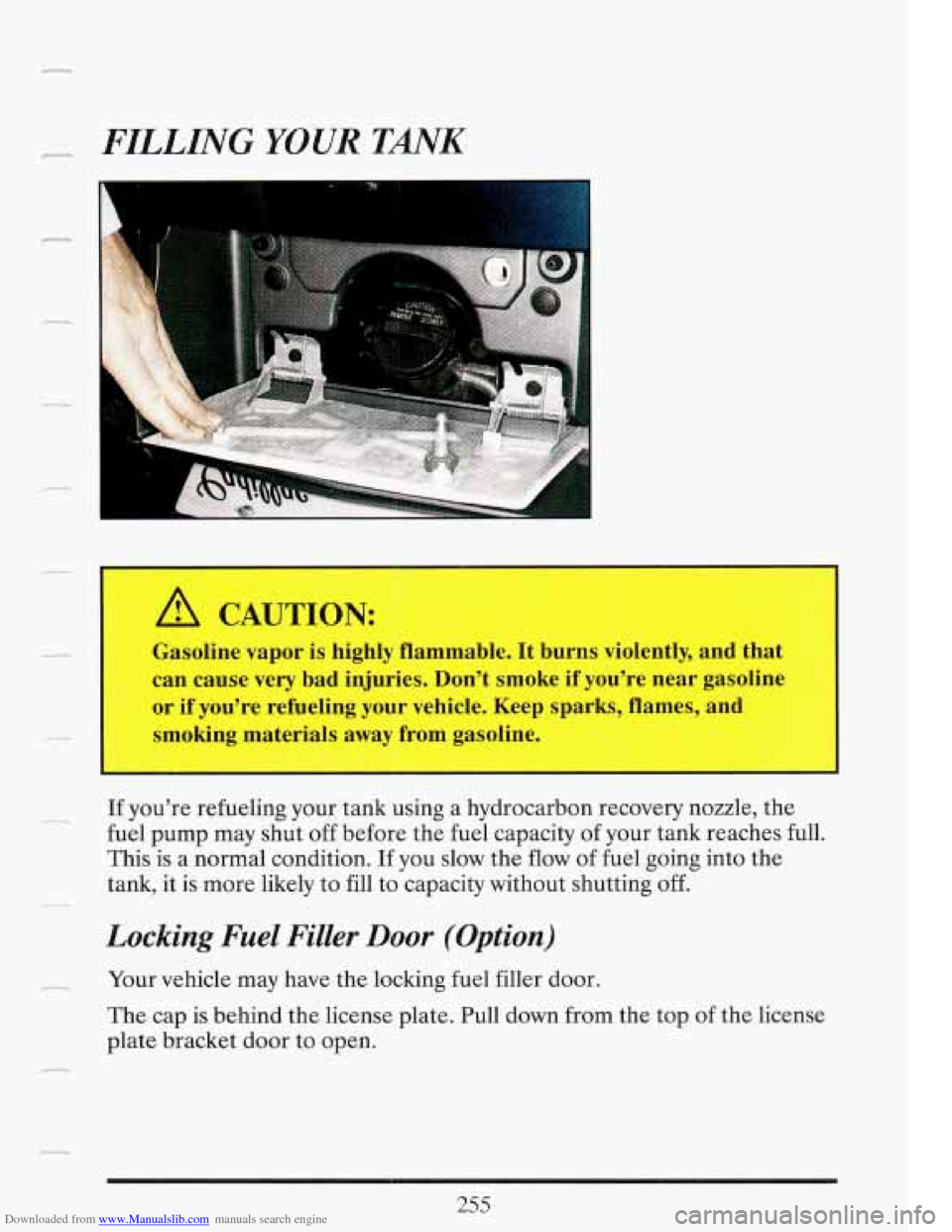
Downloaded from www.Manualslib.com manuals search engine ,s-- FILLING YOUR TANK
A CAUTION:
Gasoline vapor is highly flammable. It burns violently, and that
can cause very bad injuries. Don’t smoke if you’re near gasoline
or if you’re refueling your vehicle. Keep sparks, flames, and
I
smoking materials away from gasoline.
c_ If you’re refueling your tank using a hydrocarbon recovery nozzle, the
fuel pump may shut off before the fuel capacity of your tank reaches full.
This is a normal condition. If you slow the
flow of fuel going into the
tank, it is more likely to fill to capacity without shutting off.
__
Locking Fuel Filler Door (Option)
m Your vehicle may have the locking fuel filler door.
The cap is behind the license plate. Pull down from the top of the license
plate bracket door to open.
255
Page 274 of 386
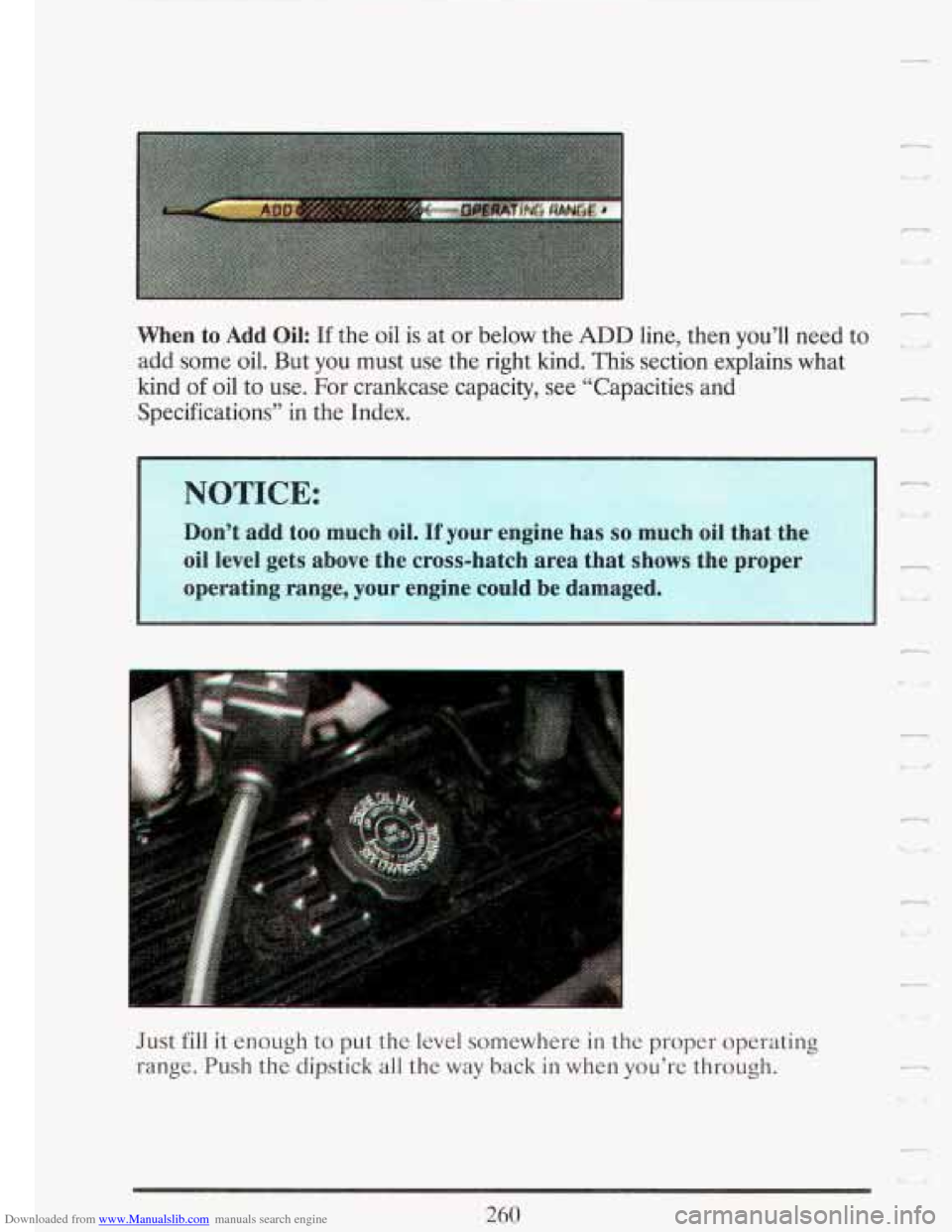
Downloaded from www.Manualslib.com manuals search engine r
When to Add Oil: If the oil is at or below the ADD line, then you’ll need to -
add some oil. But you must use the right kind. This section explains what I
kind of oil to use. For crankcase capacity, see “Capacities and
Specifications”
in the Index.
Just
fill it enough to put the level somewhere in the proper operating
range. Push the dipstick all the way back in when you’re through.
P
Page 304 of 386
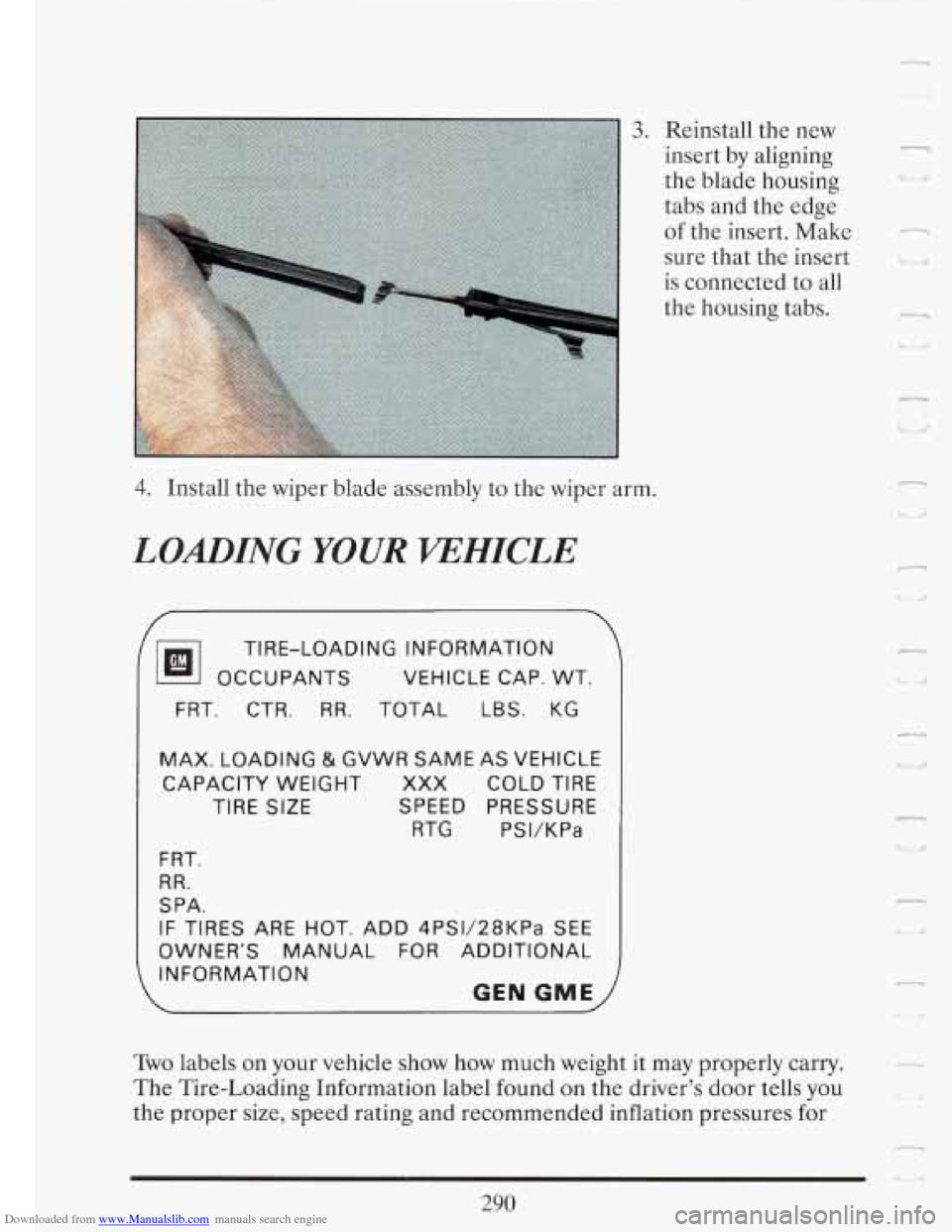
Downloaded from www.Manualslib.com manuals search engine I
3. Reinstall the new
insert by aligning
the blade housing
tabs and the edge
of the insert. Make
sure that the insert
is connected to all
the housing tabs.
4. Install the wiper blade assembly to the wiper arm.
LOmING YOUR VEHICLE
OCCUPANTS VEHICLE CAP.
WT.
TIRE-LOADING INFORMATION
FRT. CTR.
RR. TOTAL LBS. KG
MAX. LOADING & GVWR SAME AS VEHICLE
CAPACITY WEIGHT XXX COLD TIRE
TIRE
SIZE SPEED PRESSURE RTG
PSVKPa
FRT.
R R.
SPA.
IF TIRES ARE HOT. ADD 4PSV28KPa SEE
OWNER’S MANUAL FOR ADDITIONAL
INFORMATION
GEN GME
Two labels on your vehicle show how much weight it may properly carry.
The Tire-Loading Information label found on the driver’s door tells you
the proper size, speed rating and recommended inflation pressures for
n
290
Page 305 of 386
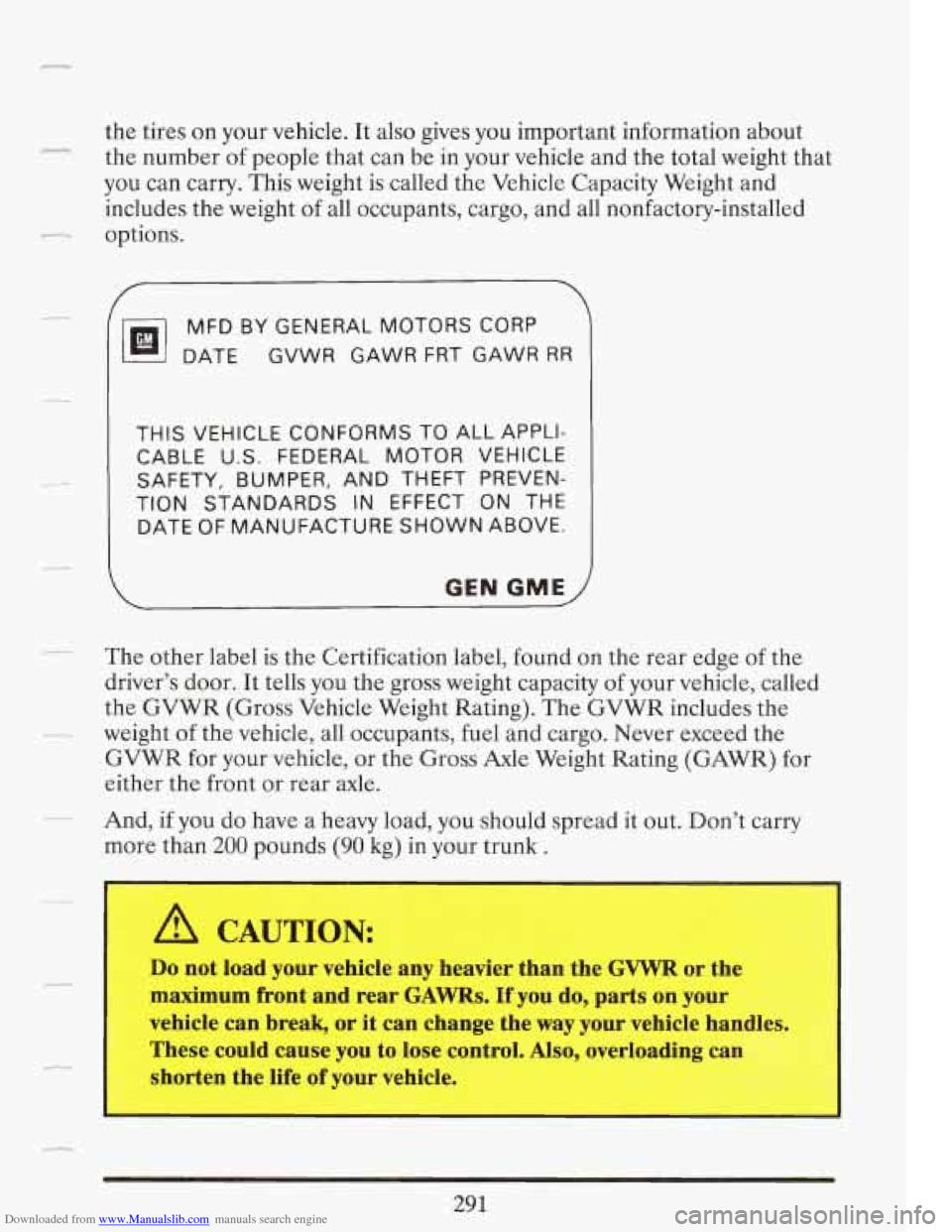
Downloaded from www.Manualslib.com manuals search engine the tires on your vehicle. It also gives you important information about
the number of people that can be in your vehicle and the total weight that
you can carry. This
weight is called the Vehicle Capacity Weight and
includes the weight
of all occupants, cargo, and all nonfactory-installed
options.
MFD BY GENERAL MOTORS CORP
DATE GVWR GAWR FRT GAWR
RR
THIS VEHICLE CONFORMS TO ALL APPLI-
CABLE
U.S. FEDERAL MOTOR VEHICLE
TION STANDARDS
IN EFFECT ON THE
DATE OF MANUFACTURE SHOWN ABOVE.
SAFETY, BUMPER,
AND THEFT PREVEN-
GEN GME /
The other label is the Certification label, found on the rear edge of the
driver’s door. It tells you the gross weight capacity of your vehicle, called
the
GVWR (Gross Vehicle Weight Rating). The GVWR includes the
weight of the vehicle, all occupants, fuel and cargo. Never exceed the
GVWR for your vehicle, or the Gross Axle Weight Rating (GAWR) for
either the front or rear axle.
And,
if you do have a heavy load, you should spread it out. Don’t carry
more than
200 pounds (90 kg) in your trunk .
A CAUTION:
Do not load your vehicle any heavier than the GVWR or the
vehicle can break, or it can change the way your vehicle handles.
These could cause you to lose control.
Also, overloading can
shorten the life
of your vehicle.
I maximum front and rear GAWRs. If you do, parts on your
I
291
Page 313 of 386
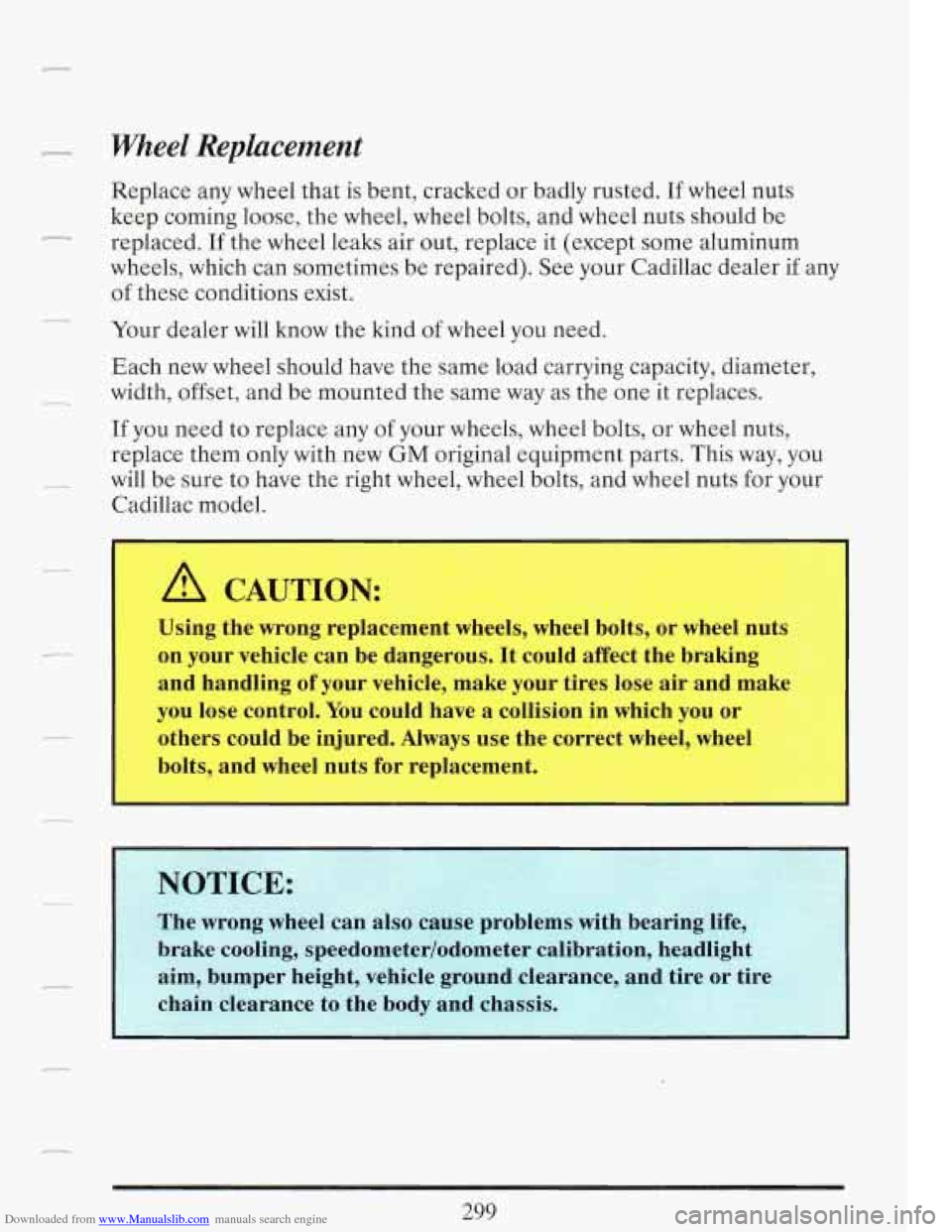
Downloaded from www.Manualslib.com manuals search engine Wheel Replacement
Replace any wheel that is bent, cracked or badly rusted. If wheel nuts
keep coming loose, the wheel, wheel bolts, and wheel nuts should be
replaced.
If the wheel leaks air out, replace it (except some aluminum
wheels, which can sometimes be repaired). See your Cadillac dealer if any
of these conditions exist.
Your dealer will know the kind
of wheel you need.
Each new wheel should have the same load carrying capacity, diameter,
width, offset, and be mounted the same way as the one it replaces.
If you need to replace any of your wheels, wheel bolts, or wheel nuts,
replace them
only with new GM original equipment parts. This way, you
will be sure to have the right wheel, wheel bolts, and wheel nuts for your
Cadillac model.
I
A CAUTION:
Using the wrong replacement wheels, wheel bolts, or wheel nuts
on your vehicle can be dangerous. It could affect the braking
and handling
of your vehicle, make your tires lose air and make
you lose control. You could have a collision in which you or
others could be injured. Always use the correct wheel, wheel
1 bolts, and wheel nuts for replacement.